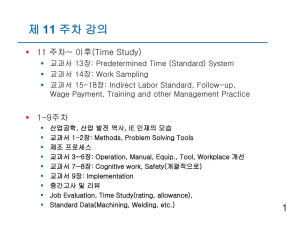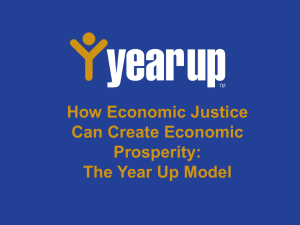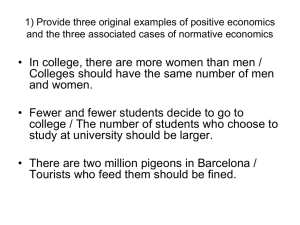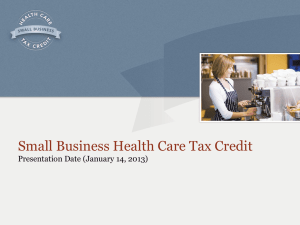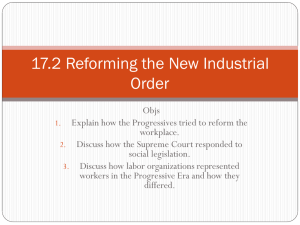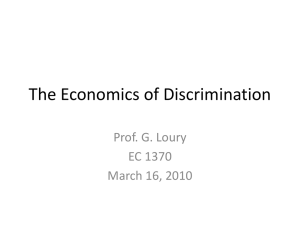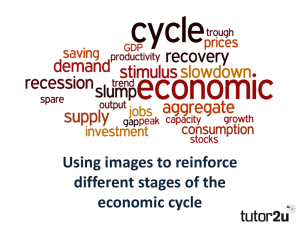Chapter 9 - The Labor Market and Wage Rates
advertisement
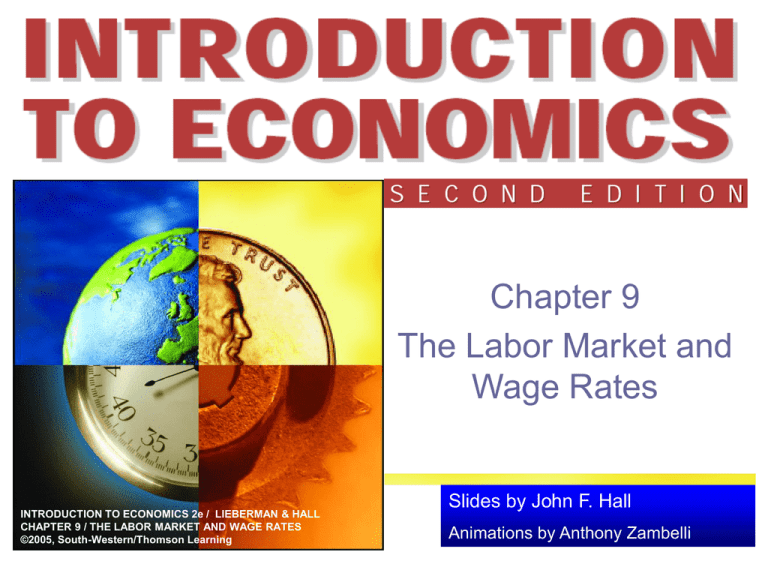
Chapter 9 The Labor Market and Wage Rates INTRODUCTION TO ECONOMICS 2e / LIEBERMAN & HALL CHAPTER 9 / THE LABOR MARKET AND WAGE RATES ©2005, South-Western/Thomson Learning Slides by John F. Hall Animations by Anthony Zambelli Labor Markets In Perspective Labor Markets differ in an important way from the other markets we’ve considered so far in this book Firms need resources to make goods and services We can identify three general categories of resource markets Markets for capital Markets for land Markets for labor Labor is different from other things that are traded Sellers of labor care about factors in the work place Another feature of labor is the meaning of the price in this market Wage rate Lieberman & Hall; Introduction to Economics, 2005 2 Figure 1: Product and Factor Markets Product Markets Demand for Goods and Services S D Households Supply of Goods and Services Firms S Supply of Resources D Demand for Resources Factor Markets Lieberman & Hall; Introduction to Economics, 2005 3 Defining a Labor Market How broadly or narrowly we define a market depends on the specific questions we wish to answer Broadly defined markets may look at markets that draw on labor from all over the world Narrowly defined markets may look at markets that draw on labor on a very localized level Lieberman & Hall; Introduction to Economics, 2005 4 Competitive Labor Markets Market with many indistinguishable sellers of labor and many buyers Involves no barriers to entry or exit Perfectly competitive labor markets must satisfy three conditions • Great many buyers (firms) and sellers (households) of • • labor in market All workers in market appear the same to firms No barriers to entering or leaving labor market Lieberman & Hall; Introduction to Economics, 2005 5 Competitive Labor Markets and The Equilibrium Wage Wage rate determined like the price of other competitive markets: The labor demand curve in any labor market slopes downward because a rise in the wage rate Supply and demand 1) increases firms’ costs, causing them to decrease production and employ fewer workers 2) increases the relative cost of labor from that market, causing firms to substitute other inputs, such as capital or other types of labor The labor supply curve in any labor market slopes upward because a rise in the wage rate 1) induces some of those not currently working to seek work 2) attracts some of those who are currently working in other labor markets The forces of supply and demand will drive a competitive labor market to its equilibrium point—the point where the labor supply and labor demand curves intersect Lieberman & Hall; Introduction to Economics, 2005 6 Figure 2: A Competitive Labor Market Hourly Wage LS $12 LD 10,000 Lieberman & Hall; Introduction to Economics, 2005 Number of Workers 7 Why Do Wages Differ? Significant inequality exists in wage rates Among different occupations Among and within occupations in U.S. labor market Wage inequality is persistent Both highest and lowest paid occupations have been so for decades Lieberman & Hall; Introduction to Economics, 2005 8 An Imaginary World To understand why wages differ in the real world, let’s start by imagining an unreal world Except for differences in wages, all jobs are equally attractive to all workers All workers are equally able to do any job All labor markets are perfectly competitive In such a world, we would expect every worker to earn an identical wage in long-run Lieberman & Hall; Introduction to Economics, 2005 9 An Imaginary World Figure 3 shows two different labor markets that initially have different wage rates In our imaginary world, could this diagram describe long-run equilibrium in these markets? • No As these shifts occur, market wage rate of elementary school teachers will rise and that of systems analysts will fall Lieberman & Hall; Introduction to Economics, 2005 10 Figure 3: Disappearing Wage Differentials (a) Hourly Wage (b) Hourly Wage S L2 S L1 S S L1 L2 B $30 A' 25 $25 A 20 LD Number of Elementary School Teachers Lieberman & Hall; Introduction to Economics, 2005 B' LD Number of Computer Systems Analysts 11 An Imaginary World When will the entry and exit stop? When there is no reason for an elementary school teacher to want to be a systems analyst • When both labor markets are paying same wage rate Long-run adjustments will occur even if no one actually switches jobs Changes will continue until—at points A’ and B’—the longrun wage rate is equal in both markets Take any one of these assumptions away, and equal-wage result disappears Tells us where to look for sources of wage inequality in real world • A violation of one or more of our assumptions Lieberman & Hall; Introduction to Economics, 2005 12 Compensating Differentials In our imaginary world, all jobs were equally attractive to all workers In real world, jobs differ in hundreds of ways that matter to workers When one job is intrinsically more or less attractive than another Can expect wages to differ by a compensating wage differential • Difference in wage rates that makes two jobs equally attractive to workers Lieberman & Hall; Introduction to Economics, 2005 13 Nonmonetary Job Characteristics When evaluating a career, whether you are aware of it or not, you are evaluating hundreds of nonmonetary job characteristics, including Risk of death or injury Cleanliness of work environment Prestige you can expect in your community Amount of physical exertion required Degree of intellectual stimulation Potential of advancement Lieberman & Hall; Introduction to Economics, 2005 14 Nonmonetary Job Characteristics You will also think about geographic location of job and characteristics of the community in which you would live and work Weather Crime rates Pollution levels Transportation system Cultural amenities Nonmonetary characteristics of different jobs give rise to compensating wage differentials Jobs considered intrinsically less attractive will tend to pay higher wages, other things being equal Lieberman & Hall; Introduction to Economics, 2005 15 Nonmonetary Job Characteristics What about unusually attractive jobs? These jobs will generally pay negative compensating differentials Different people have different tastes for working and living conditions Cannot use our own preferences to declare a job as less attractive or more attractive Or to decide which jobs should pay a positive or negative compensating differential • Rather, when labor markets are perfectly competitive Entry and exit of workers automatically determines compensating wage differential in each labor market Lieberman & Hall; Introduction to Economics, 2005 16 Nonmonetary Job Characteristics Compensating wage differentials are one reason most economists are skeptical about idea of comparable worth Holds that a government agency should determine skills required to perform different jobs and mandate wage differences needed between them Economists generally prefer policies to increase competition and eliminate discrimination So that the market itself can determine comparable worth Lieberman & Hall; Introduction to Economics, 2005 17 Cost of Living Differences Differences in living costs can cause compensating wage differentials Areas where living costs are higher than average will tend to have higher than average wages • To compensate for the higher cost of living Lieberman & Hall; Introduction to Economics, 2005 18 Differences in Human Capital Requirements All else equal, jobs that require more education and training will be less attractive In order to attract workers, these jobs must offer higher pay than other jobs that are similar in other ways, but require less training Differences in human capital requirements can give rise to compensating wage differentials Jobs that require more costly training will tend to pay higher wages, other things equal Compensating differentials explain much of the wage differential between jobs requiring college degrees and requiring only a high school diploma The idea of compensating wage differentials dates back to Adam Smith First observed that unpleasant jobs seem to pay more than other jobs that require similar skills and qualifications Lieberman & Hall; Introduction to Economics, 2005 19 Differences In Ability Not everyone has the intelligence needed to perform well at any job Scientific discoveries and technological advances have increased not only skill requirements of many jobs But also abilities needed to acquire those skills In general, those with greater ability to do a job well—based on their talent, intelligence, motivation, or perseverance— will be more valuable to firms Firms will be willing to pay them a higher wage rate • Beyond any compensating differential for their human capital investment Lieberman & Hall; Introduction to Economics, 2005 20 The Economics of Superstars Why was owner of Texas Rangers willing to pay $25 million per year to have Alex Rodriguez play for his team? Immediate answer • Because Rodriguez is so good When we try to explain extremely high wage rates of these superstars based on their exceptional abilities alone, we confront a puzzle The very top writers, rock stars, comedians, talk-show hosts, and movie directors all earn wage premiums that seem vastly out of proportion to their additional abilities Why? Explanation in all these cases is based on ability And also by exaggerated rewards market bestows on those deemed the best or one of the best in a field Lieberman & Hall; Introduction to Economics, 2005 21 The Economics of Superstars If most people rank recent mystery novels in the same order, then the best will sell millions of copies, second best will sell hundreds of thousands, and third best might sell only thousands Even though all three novels might be very close in quality A publisher will earn ten times more revenue selling the best novel (compared to the second best), and ten times more revenue selling the second best (compared to the third best), and so on Same thing happens in markets for athletes, rock concerts, action movies, and news broadcasters But phenomenon is not limited to media markets or media stars Lieberman & Hall; Introduction to Economics, 2005 22 Barriers to Entry In some labor markets, barriers keep out would-be entrants Resulting in higher wages in those markets Since barriers to entry help maintain high wages for those protected by the barriers—those who already have jobs in the protected market Should not be surprised to find that in almost all cases, it is those already employed who are responsible for erecting barriers Lieberman & Hall; Introduction to Economics, 2005 23 Occupational Licensing In many labor markets, occupational licensing laws keep out potential entrants American Medical Association (AMA) is perhaps the strongest example of occupational licensing as a barrier to entry Professional organization to which almost half of American physicians belong Much of AMA’s activity has been designed to decrease supply of doctors AMA has also increased demand for physicians’ services by preventing nonphysicians from competing In late 1980’s, rising health care costs led to increased public scrutiny of AMA, and its anticompetitive practices came under heavy attack Economists see AMA primarily as an instrument to maintain high incomes for doctors Lieberman & Hall; Introduction to Economics, 2005 24 Figure 4: The Market for Physicians Physicians' Salaries 2. AMA restrictions on the supply of physicians move the market here. S L2 S L1 C W3 W2 W1 B A D L2 D L1 1. Without AMA activities to increase salaries, equilibrium is here, at wage rate W1. Lieberman & Hall; Introduction to Economics, 2005 3. Other policies to increase demand for physicians move the market here, at final wage rate W3. Number of Physicians 25 Union Wage Setting A labor union represents collective interests of its members Major objective of a union is to raise its members’ pay Higher union wage is contrary to interests of employer— so why does employer agree? • Because union has power to strike In a competitive labor market, a union—by raising the wage firms must pay—decreases total employment in the union sector This, in turn, causes wages in non-union sector to drop Result is a wage differential between union and nonunion wages Lieberman & Hall; Introduction to Economics, 2005 26 Figure 5(a): Union Wage Differentials (a) Wage 2. A union wage of for long-haul truckers of W2 creates an excess supply of workers. W2 W1 LS A' A 1. With no labor union, both longand short-haul truckers earn the same wage rate, W1. LD 250,000 350,000 300,000 Number of Long-haul Truckers Lieberman & Hall; Introduction to Economics, 2005 27 Figure 5(b): Union Wage Differentials (b) Wage 3. Unemployed long-haul truckers move to the nonunion short-haul market, and the labor supply curve shifts rightward . . . S L1 S L2 B W1 W3 B' LD 200,000 225,000 Lieberman & Hall; Introduction to Economics, 2005 4. pushing the short-haul wage rate down to W3. Number of Shorthaul Truckers 28 Union Wage Setting Unions still maintain a significant, though declining, presence in many industries Such as automobiles, steel, coal, construction, mining, and trucking Certainly responsible for at least some of the higher wages earned in those industries Full effect of unions on labor markets is much more complex Many of the features of modern work that we take for granted today originated in union struggles with management Such as paid vacations and overtime pay Unions can raise workers morale and reduce labor turnover Through grievance procedures and other forms of communications with management Lieberman & Hall; Introduction to Economics, 2005 29 Discrimination and Wages Discrimination occurs when members of a group of people have different opportunities because of characteristics that have nothing to do with their abilities First step in understanding economics of discrimination is to distinguish two words that are often confused Prejudice • Emotional dislike for members of a certain group Discrimination • Restricted opportunities offered to such a group Lieberman & Hall; Introduction to Economics, 2005 30 Employer Prejudice When you think of job discrimination, your first image might be a manager who refuses to hire members of some group because of pure prejudice Such as African-Americans or women May surprise you to learn that economists generally consider employer prejudice one of the least important sources of labor market discrimination When prejudice originates with employers, market forces work to discourage discrimination and reduce or eliminate any wage gap between favored and unfavored group Lieberman & Hall; Introduction to Economics, 2005 31 Employee and Customer Prejudice What if workers—rather than employers—are prejudiced? In a competitive output market, non-discriminating firm will be forced out of business • Cannot count on the market to solve the problem Same argument applies if the prejudice originates with firm’s customers When prejudice originates with firm’s employees or its customers Market forces may encourage, rather than discourage, discrimination • Can lead to a permanent wage gap between favored and unfavored groups Lieberman & Hall; Introduction to Economics, 2005 32 Figure 6: Employer Discrimination and Wage Rates Sector A (Discriminating) Sector B (Nondiscriminating) Wage Wage S L2 W3 W1 E' S L1 S L1 S L2 F W1 E W2 LD Number of Workers Lieberman & Hall; Introduction to Economics, 2005 F' LD Number of Workers 33 Statistical Discrimination Suppose you are in charge of hiring 10 new employees at your firm Young married women in your industry are twice as likely to quit their jobs within two years than men and those that quit are very costly to your firm 20 people apply for 10 positions—half men and half women • Whom will you hire? If your sole goal is to maximize the firm’s profit You will hire men Even if there isn’t a trace of prejudice in you, in the firm’s employees, or in its customers, profit maximization may still dictate hiring the men Lieberman & Hall; Introduction to Economics, 2005 34 Statistical Discrimination When individuals are excluded from an activity based on the statistical probability of behavior in their group Rather than their personal characteristics Some observers have suggested that statistical discrimination is often a cover for prejudice According to critics of the statistical discrimination theory, the negative behavior of a favored group is rarely considered by employers Lieberman & Hall; Introduction to Economics, 2005 35 Dealing With Discrimination Discrimination due to pure employer prejudice is unlikely to have much of an impact on labor markets For other types of discrimination market incentives work in the opposite way, leading to a permanent and stubborn problem Such as statistical discrimination or discrimination due to worker or consumer prejudice • In these cases, many economists and other policy makers believe that government action is needed Some favor affirmative action programs Others favor stricter enforcement of existing antidiscrimination laws and stiffer penalties when discriminatory hiring occurs Both approaches to policy force all firms to bear costs of nondiscriminatory hiring Lieberman & Hall; Introduction to Economics, 2005 36 Discrimination and Wage Differentials Consider the black-white differential for men Several studies suggest that if we limit comparisons to whites and blacks with same educational background, geographic location, and, in some cases, same ability (measured by a variety of different tests), 50% or more of the earnings difference disappears In addition to job-market discrimination, there is pre-market discrimination Occurs before an individual enters labor market • Such as unequal treatment in education and housing For women, as well as blacks and other minorities, differences in skills and experience can be the result of lower wages Since women know they will earn less than men and will have more trouble advancing on the job • They have less incentive to invest in human capital and to stay in labor force Lieberman & Hall; Introduction to Economics, 2005 37 Discrimination and Wage Differentials In the end, we do not know nearly as much about the impact of discrimination on wages as we would like to know But research is proceeding at a rapid pace As we’ve seen, data must always be interpreted with care In measuring impact of job market discrimination on earnings • Wage gap between two groups gives an overestimate Since it fails to account for differences in skills and experience However, comparing only workers with similar skills and experience leads to an underestimate • Since some of the differences are themselves caused by discrimination—both in the job market and outside of it Lieberman & Hall; Introduction to Economics, 2005 38 Figure 7: Vicious Cycle of Discrimination Current Job Discrimination Pre-market Discrimination Lieberman & Hall; Introduction to Economics, 2005 Lower Wage Lower Human Capital Investment Unemployment Lower Skill Level Less Job Experience 39 Using The Theory: The Minimum Wage Minimum wage law…makes it illegal to hire a worker for less than a specified wage In any labor market covered by the law Most people think about the minimum wage as a means to increase living standards for the lowest paid workers, and their analysis stops there But minimum wage creates a wage differential among the least-skilled workers, depending on the industry in which they work By raising wages rates in covered industries, and lowering them in uncovered industries Lieberman & Hall; Introduction to Economics, 2005 40 Figure 8(a/b): The Minimum Wage (a) (b) Unskilled Labor Covered by Law Unskilled Labor Not Covered by Law Hourly Hourly A minimum wage raises Wage Wage pay, but decreases jobs in the covered sector. $5.15 4.00 LD A N1 $4.00 3.00 S L2 LS A' N2 S L1 B B' LD Some who can't find work go to the uncovered sector, lowering wages there. N3 Number of Workers Lieberman & Hall; Introduction to Economics, 2005 Number of Workers 41 Figure 8(c): The Minimum Wage (c) Hourly Wage $24.00 20.00 Skilled Labor LS C' C D L2 As capital is substituted for unskilled labor, demand for skilled workers goes up, raising the skilled wage rate. D L1 Number of Workers Lieberman & Hall; Introduction to Economics, 2005 42 Using The Theory: The Minimum Wage Only one group of workers in which everyone benefits: skilled workers Should come as no surprise that for many decades the most vocal advocates of raising the minimum wage have been labor unions • Membership is disproportionately made up of skilled workers What do economists think about the minimum wage? Most regard it as an inefficient policy for helping poor working families Lieberman & Hall; Introduction to Economics, 2005 43 Using The Theory: The Minimum Wage You might think that economists would overwhelmingly oppose any increase in minimum wage But that is not the case • Those who favored an increase in minimum wage tended to believe the effect on unemployment was much smaller than those who opposed an increase • Others may believe that higher unemployment is more likely to influence policy in a direction they favor The minimum wage, like most issues of public policy, is not as simple as it appears Lieberman & Hall; Introduction to Economics, 2005 44

